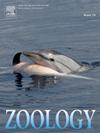Kinematics of elongate harvestmen chelicerae: Comparative range of motion analyses in extant Ischyropsalis (Dyspnoi, Opiliones)
IF 1.6
3区 生物学
Q2 ZOOLOGY
引用次数: 0
Abstract
Chelicerae, the mouthparts of chelicerates, are essential for food processing. Particularly within harvestmen (Opiliones), some species have greatly elongated their tripartite chelicerae and utilize them for mating behavior, defense, and primarily for predation. We investigated two European species, Ischyropsalis muellneri and Ischyropsalis hellwigii, which occupy different niches (caves, forests), exhibit different feeding ecologies (opportunist, specialist), and first and foremost possess different chelicerae morphologies (long and thin, short and robust). We scanned the specimens using state-of-the-art micro-CT, generated surface reconstructions, and equipped one chelicera of each specimen with artificial joints to explore their Range of Motion in a 3D kinematic approach. For a size-corrected comparison of the two species, we analyzed the Range of Motion in addition to three different settings (original body size, body scaled to 5 mm, chelicerae scaled to 5 mm). Ischyropsalis muellneri reached a higher maximum excursion angle (= single Range of Motion) in all three joints, also exhibiting a greater total Range of Motion in the original body length setting, as well as the scaled body length setting. Only in the third setting, the total Range of Motion of Ischyropsalis hellwigii was slightly higher, although Ischyropsalis muellneri still extended further ventrally. Our results suggest that the sturdier, more massive chelicerae of Ischyropsalis hellwigii, attributable to strong specialization on snails as prey, are associated with reduced Range of Motion. The less food-specialized species Ischyropsalis muellneri apparently requires higher flexibility of its chelicerae for prey capture, likely due to its restriction to cave ecosystems, where food availability is relatively scarce. We could show that virtual Range of Motion analyses in harvestmen chelicerae can play a pivotal role in understanding the theoretical feeding ecology and functional morphology of this group. This approach can be verified by in-vivo observations and measurements or extended to other arachnid taxa and other body parts.
细长栉水母的运动学:现生伊斯基罗珀斯虫(Dyspnoi,Opiliones)的运动范围比较分析
螯肢是螯足类的口器,对食物加工至关重要。特别是在禾本科动物(Opiliones)中,一些物种大大拉长了它们的三瓣螯肢,并利用它们进行交配行为、防御和主要的捕食。我们研究了两个欧洲物种:Ischyropsalis muellneri 和 Ischyropsalis hellwigii,它们占据着不同的生态位(洞穴、森林),表现出不同的摄食生态(机会主义者、专食者),而且首先拥有不同的螯肢形态(细长、短而粗壮)。我们使用最先进的微型计算机断层扫描技术对标本进行扫描,生成表面重建图,并为每个标本的一个螯肢配备人工关节,以三维运动学方法探索它们的运动范围。为了对两个物种进行尺寸校正比较,我们分析了三种不同设置(原始身体尺寸、身体缩放至 5 毫米、螯足缩放至 5 毫米)下的运动范围。Ischyropsalis muellneri的三个关节都达到了更大的最大偏移角度(=单次活动范围),在原始体长设置和按比例缩放体长设置中也表现出更大的总活动范围。只有在第三种情况下,Ischyropsalis hellwigii的总活动范围略大,尽管Ischyropsalis muellneri仍向腹侧延伸得更远。我们的研究结果表明,Ischyropsalis hellwigii的螯更坚固、更巨大,这是因为它们专门捕食蜗牛,这与它们的活动范围减小有关。对食物专一性较低的物种Ischyropsalis muellneri显然需要更灵活的螯来捕获猎物,这可能是由于它只能生活在食物相对稀缺的洞穴生态系统中。我们可以证明,禾本科动物螯肢的虚拟运动范围分析可以在理解该类动物的理论摄食生态学和功能形态学方面发挥关键作用。这种方法可以通过体内观察和测量进行验证,也可以推广到其他蛛形纲类群和其他身体部位。
本文章由计算机程序翻译,如有差异,请以英文原文为准。
求助全文
约1分钟内获得全文
求助全文
来源期刊

Zoology
生物-动物学
CiteScore
3.90
自引率
0.00%
发文量
37
审稿时长
70 days
期刊介绍:
Zoology is a journal devoted to experimental and comparative animal science. It presents a common forum for all scientists who take an explicitly organism oriented and integrative approach to the study of animal form, function, development and evolution.
The journal invites papers that take a comparative or experimental approach to behavior and neurobiology, functional morphology, evolution and development, ecological physiology, and cell biology. Due to the increasing realization that animals exist only within a partnership with symbionts, Zoology encourages submissions of papers focused on the analysis of holobionts or metaorganisms as associations of the macroscopic host in synergistic interdependence with numerous microbial and eukaryotic species.
The editors and the editorial board are committed to presenting science at its best. The editorial team is regularly adjusting editorial practice to the ever changing field of animal biology.
 求助内容:
求助内容: 应助结果提醒方式:
应助结果提醒方式:


